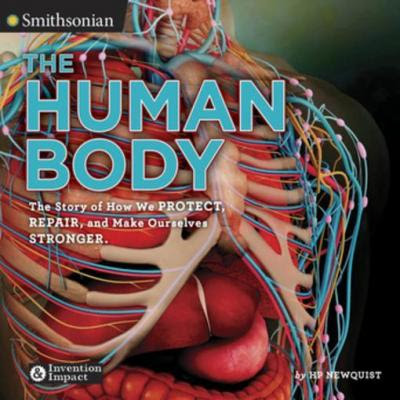 |
| First in a new Smithsonian series from Viking, The Human Body, by H. P. Newquist The Story of How We Protect, Repair, and Make Ourselves Stronger |
The Story of How We Protect, Repair, and Make Ourselves Stronger
Written by H. P. Newquist
Smithsonian: Invention & Impact (Book 1)
Viking Books for Young Readers, 2015
Ages 8 and up
112 pages, Lexile 1130
Themes:
Non-fiction, Science
Overview:
“We’re going to see how flesh and bone have given way to wood and metal, glass and gold, carbon fiber and computers,” says the introduction to this overview of medical innovations. The first section, “Body Parts,” which takes up more than half of the book, focuses on the history of prosthetics and replacements, from glass eyes to dental implants to artificial hearts; the middle section, “The Medicine Cabinet,” focuses on soap, aspirin, and antibiotics; a final section, “Tools and Treatments,” talks about the development of surgery, ways to peek inside the body and its processes from stethoscopes to MRIs, and vaccines. ... Reproductions of period and contemporary images, sometimes adding a gross and/or a cool factor, enliven the pages; a list of web and print resources and an index are included.
Overview courtesy Project Muse
Thoughts:
This book focuses on what humans do to repair and improve body parts and functions. I find that a fascinating approach and a great way to organize the material so kids will want to read it. The material is never dry, but enthusiastic and optimistic. Middle schoolers are bound to oh and ah over the history of prosthetics, the torture-like tools of early medicine, and the technological advances presented in this collection.
Did you know eyes were made from more than just glass or porcelain? False eye balls have been manufactured from rubber, cork, bone, wax, wool, and even gold. Did you know where the inventor of contact lenses got his inspiration? He realized there was no infection around the glass shards imbedded in fighter pilots eyes. Gross!
Did you know the Egyptians were some of the first to use false teeth, but they were for mummified bodies, not the living! Early false teeth in other civilizations were carved from sea shells or collected from dead people.
Did you know how early doctors scraped the pus from cow pustules, inserting it into cuts on their patients' arms to prevent further infection? How many were ridiculed and arrested?
Find out about mummification. See the progression from peg legs to modern running blades. Learn how aspirin finds the headache and what happened to Marie Curie's notebooks.
The author relates a smattering of cutting-edge examples as well, from the scientist who has implanted a communication device in both his and his wife's arms which they can feel anywhere in the world, to the mid-western dad who was able to download and print a prosthetic hand for his middle-schooler—for under $20!
As a creationist, I did find a few misleading "facts" and I shuddered at the philosophy that science should be used to "improve" the body's design. But the author presents even these viewpoints without moral comment. He never tackles the consequences of past or present methods. I see that as an opportunity for discussion rather than a disappointing lack of ethics. I enjoyed the author's passion for the subject and his presentation, allowing readers to form their own judgments.
This is the ultimate coffee table book. Browse. Marvel. Repeat.

Have you reviewed a Marvelous Middle Grade Book along this theme? Please leave the link in the comments below. Thanks!
Check out all the Marvelous Middle Grade Monday recommendations for November 14, 2016.
MMGM started way back in 2010 by Shannon Messenger, author of Keeper of Lost Cities. Each week, participating bloggers review our favorite books for ages 8-12. Why not join us?
Kids who like facts and interesting pieces of information will be drawn to this book. I will admit I found some of what you shared interesting. Didn't know about the Egyptians being the first to use false teeth.
ReplyDeleteYour page didn't show properly on the MMGM site. But, I located your post on the right sidebar.
Thank you. So sorry about the bad links. Shannon accidentally posted last week's link which wasn't working anyway. I put the links for both reviews in the comments, but know that they're hard to find there. Thanks for letting me know. Sigh. One of these weeks I'll get the link thing correct in my Sunday night email to her.
ReplyDeleteThis is a favorite recent read. I really believe it will be a hit with young readers, especially those who are thrilled with the "maker spaces" emerging around them. The solutions to failing/damaged human body parts are innovative and intriguing and, from the past or present, they should inspire any number of future bioengineers.
ReplyDeleteI hope that is true. This book deserves to be put into the hands of the next generation and I plan to include a copy on my next book order for our school. Thanks for visiting.
Delete